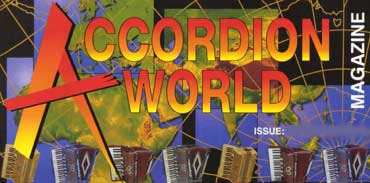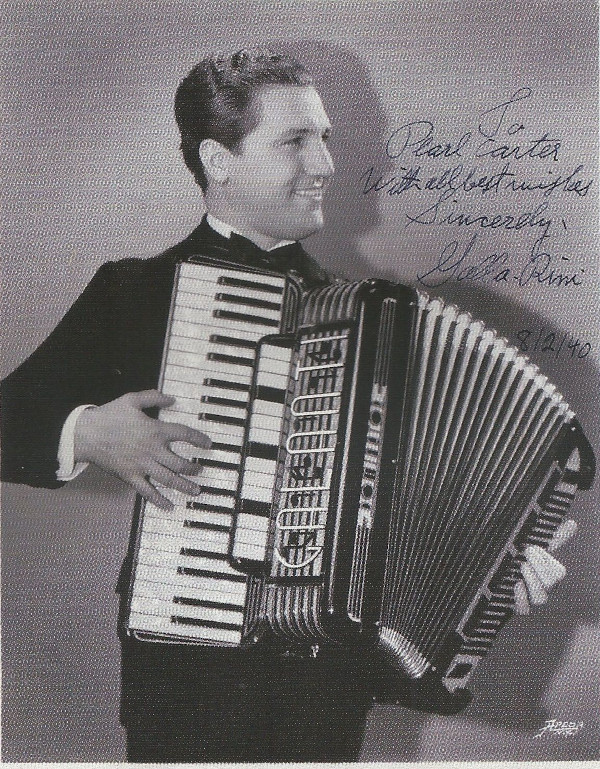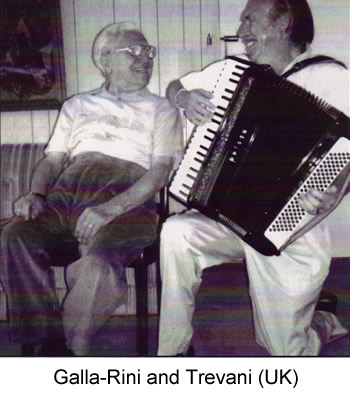
(See our review of Accordion World Magazine).

|
The following essay was originally published in the September/October 2006 edition of Accordion World magazine (editor: David Keen) and is presented here by the permission of Accordion World. (See our review of Accordion World Magazine). |
 Anthony Galla-Rini came to Kansas City, Missouri, USA to give solo concerts several times during his concert career. My teacher, Cecil Cochran, sponsored him
every time, whether it was for a solo recital or for the many days of group rehearsals and workshops that he also presented. When I was 14 years of age, arrangements were made for some of
Mr. Cochran's students to play a solo for Galla-Rini, who was a very handsome, well-dressed gentleman whom everyone thought was really an Italian Hollywood idol who could play this fantastic
music on the accordion. Naturally, we were absolutely terrified and, in fact, my younger brother was so scared that he began fiddling with an open window and it fell on his fingers,
making him just that much more anxious and far less able to play well.
Anthony Galla-Rini came to Kansas City, Missouri, USA to give solo concerts several times during his concert career. My teacher, Cecil Cochran, sponsored him
every time, whether it was for a solo recital or for the many days of group rehearsals and workshops that he also presented. When I was 14 years of age, arrangements were made for some of
Mr. Cochran's students to play a solo for Galla-Rini, who was a very handsome, well-dressed gentleman whom everyone thought was really an Italian Hollywood idol who could play this fantastic
music on the accordion. Naturally, we were absolutely terrified and, in fact, my younger brother was so scared that he began fiddling with an open window and it fell on his fingers,
making him just that much more anxious and far less able to play well.
However, in spite of the surrounding excitement and general angst among both parents and students, I performed one of his recent arrangements for him and apparently he was pleased. From that early performance for Anthony Galla-Rini, however. I received the invitation to travel to New York City to be a member of his master class session he was holding. The invitation was only valid if I would learn about 15 solos that he assigned for me to learn in the next few months.
I turned 15, began to learn all of them and was given a scholarship that covered my travel expenses so my mother and I took our first airplane ride and flew to the big city of N.Y. Needless to say, the experience had a great influence on me. It was my real introduction to Anthony Galla-Rini as a teacher, one who became my lifelong friend and mentor as well.
Tony came to Kansas City for several summers and would stay for a period of three weeks, perhaps, while he rehearsed our accordion orchestra, although they were often called bands in those days. He would send many of his arrangements but would also include a few from Europe that he had obtained on a recent tour or from his overseas friends. Our orchestra would practice the parts and then Tony would come to Kansas City and really put us through the wringer. It was indeed a wringer since, at that time, no one had air conditioning and the summers were hot and humid!
We worked many hours a day, day after day after day, until we were ready to perform in Chicago during the NAME Convention period, sometimes sponsored by Galla-Rini in Kimball Hall and other times sponsored by either the Titano or Giulietti Accordion Company during their trade-show concerts. It was an exciting time and on each of these concerts, Tony would premiere the newest of his hundreds of accordion orchestra arrangements, always conducting from memory with great dignity, a trait that never diminished or faltered even at the age of 100 when he needed to sit while conducting. None of us in the orchestra, or those in the large audience, could ever forget the first time we played his arrangement of the Finale to Tschaikovsky's Fourth Symphony. That arrangement, along with the Dance of the Buffoons by Rimsky-Korsakov, probably became the absolute favourite competition piece performed by all accordion orchestras in the United States for a very long time.
During these same concerts, Anthony would play several solos, always new and always with at least one selection that no one else would ever have attempted because of the intricate technical passages required in the left hand. What others always thought impossible, Tony would attempt and prove that there was always more the accordionist's left hand could do. At that time, he could only switch to move between the various octaves, there were no free basses for a few years yet.
But switch he did and he made his students learn to do so as well. In his workshops, he gave us page after page of melodic exercises in which we were required to mark the correct switches, and fingerings, in order to stay in the exact pitches written on the music. He always thought the left hand should be equal to that of the right hand and did everything in his power as a teacher to help his students to achieve that. To this very day, I have stacks of the numerous exercises he wrote out for us to practice.
Anthony Galla-Rini did not focus only on left-hand technique: he also taught right-hand technique, but always with a hint of a music theory teacher's viewpoint, I think. We did not just play exercises, we learned theoretically what it was we were playing. Galla-Rini was a real teacher and introduced us to the books that served as his resources for his own volumes of "treatises" on various musical topics with multitudinous subject matters, often far above our comprehension at that precise moment. Those early lessons have continued to be valuable throughout the many years of my own and many others' teaching careers.
During one long period of time, Anthony Galla-Rini served as the Chief Examiner for the Accordion Institute of America's yearly Syllabus Examinations in Kansas City. Students, including myself, were given the usual examinations regarding repertoire performance, aural tests of all sorts, and written music theory. It was a grand occasion when Tony would set up his "testing room" where he would hold examinations for several days at a time and he would rejoice as much as the candidates when they passed each successive syllabus level. He was a strict adjudicator but one who often gave second chances when needed! And during the evening hours of relaxation, while enjoying a dinner, a fine wine, and friendly conversation, he was full of fun, tales of his work in the movies with famous stars or directors, with musical wit as well as the latest news from his colleagues throughout the accordion world. There was another example of Anthony Galla-Rini's personal character, also, when it came to paying the restaurant bill for the evening: Tony always remembered when it was his time to pay or at least share the costs. Yes, he was a true gentleman in addition to being a great musician and these were during times when I am sure he, as the case with most musicians without a weekly salary, needed to watch his pennies. Regardless of all the work he did and of all the thousands of arrangements he made that were published, Tony had to work hard for his money and he did so his whole life.
 There are many musicians born with absolute or perfect pitch, but none who could have surpassed or even approached the accuracy exhibited by Tony Galla-Rini! He could hear everything: there simply was no way to fool him. Of course, he also knew every note of every piece, solo or orchestral, so he knew what he was supposed to be hearing. His
arrangements were never equalled in his day because of his total devotion to writing
them as the composer would have written them originally, as if for the accordion in the first place. His tremendous knowledge of music theory and harmony, coupled with his own genius as a composer, arranger, and performer, simply made him better than all others. He omitted nothing; if the composer wrote it, he put it in. If there were cuts made, because of time limits or lack of suitability, he always seemed to make the correct ones! While other arrangements might sound thin, without the inside middle voices, or perhaps even with wrong notes, Anthony Galla-Rini's were always correctly analysed in the first place. And in the second place, he knew how to put it on manuscript. He knew how to use the abilities of the accordionist and he knew the possibilities of the instrument. His accuracy in doing so was simply superb and without fault to the very end. Even in his very advanced age of 99 and even 100, he continued to write those very distinguishable, recognisable and readily readable notes on the page without mistakes, truly another of his remarkable qualities!
There are many musicians born with absolute or perfect pitch, but none who could have surpassed or even approached the accuracy exhibited by Tony Galla-Rini! He could hear everything: there simply was no way to fool him. Of course, he also knew every note of every piece, solo or orchestral, so he knew what he was supposed to be hearing. His
arrangements were never equalled in his day because of his total devotion to writing
them as the composer would have written them originally, as if for the accordion in the first place. His tremendous knowledge of music theory and harmony, coupled with his own genius as a composer, arranger, and performer, simply made him better than all others. He omitted nothing; if the composer wrote it, he put it in. If there were cuts made, because of time limits or lack of suitability, he always seemed to make the correct ones! While other arrangements might sound thin, without the inside middle voices, or perhaps even with wrong notes, Anthony Galla-Rini's were always correctly analysed in the first place. And in the second place, he knew how to put it on manuscript. He knew how to use the abilities of the accordionist and he knew the possibilities of the instrument. His accuracy in doing so was simply superb and without fault to the very end. Even in his very advanced age of 99 and even 100, he continued to write those very distinguishable, recognisable and readily readable notes on the page without mistakes, truly another of his remarkable qualities!
His understanding of how the left-hand mechanisms worked caused him to merely open up the instrument, cut off the offending 5th of the dominant and diminished seventh stradella chord buttons. Galla-Rini was thereby again paying homage to the rules of harmony and, in so doing, allowed all accordionists far greater opportunities for use of the stradella chords. He was an innovator but it was always for the benefit of the music. Switches on an accordion were placed there to be used, not just to decorate or sell the instrument. Tony used them and he made his students use them properly. I have already alluded to this uncanny ability of his left hand to play tremendously difficult passages and play them in the correct octave. He was just as obsessed with teaching his students the need for understanding correct pitches or octaves in the right hand and how the switches should be used. Middle C was not allowed to move willy-nilly over the keyboard unless the correct switch accompanied the move. It was during these many sessions that I, personally, began to be fascinated with orchestral scores, particularly, and how to understand the different qualities of timbre and their relationships to the accordion. He opened my eyes to the works of so many composers, including those of the familiar traditional keyboard repertoire, but perhaps most especially to those of the great orchestral works.
Anthony Galla-Rini was a demanding person, not only of others but also, especially of himself. He expected the best from himself and from his students. There was friendliness and kindness, but always with a firm understanding that he was indeed the master. This was perhaps a throwback to an earlier era, but most certainly warranted in the instance of this great man who came to be known as The Maestro in his later years at his many music camps. Even then he exhibited the elegance required of and demanded by such a title so lovingly bestowed upon him.
Literally hundreds and hundreds of players have shared the genius of Anthony Galla-Rini through the playing of his vast numbers of arrangements for solo and orchestra. While some of those were made in response to the dictates of a certain period of time, many others will remain in the repertoire and libraries of accordionists, valuable for both teaching and performance, for students and professionals. His two concerti were perhaps his finest efforts at composition, an art he thoroughly understood. Anthony Galla-Rini also knew intimately each and every instrument for which he wrote and because of this, he composed every note for every instrument; the orchestrations were not left to anyone else. His Concerto No. 1 in g minor is undoubtedly the most performed of any accordion concerto, at least in the United States, if not in the world.
His wife, Dina, came from a famous accordion family and was a person who doted on her husband; she sat and listened to every note, every day, wherever and whenever. After she died and Tony remarried, his second wife, Dolly, was the same; she also travelled with him and listened to everything he did with great admiration. I considered it a great privilege to share many good times with both Dina and Dolly and to have had them as my very good friends.
I, like hundreds of other accordionists, have many wonderful memories of Anthony Galla-Rini and they will never be forgotten. The world will never forget him since he was a giant in the history of the accordion in so many different ways. From his early years as a child performer growing up in vaudeville and continuing on through practically his last days on earth at the age of 102, his story is well known through the hundreds of articles written about his life and his many accomplishments. But my memories include not only those I have read about but, also, the ones I had the inordinate privilege of sharing as a student, friend and, eventually, a colleague. God blessed us all with the presence and life of Anthony Galla-Rini. He was a good human being and a great musician! May his legacy live on forever.
Copyright 2006